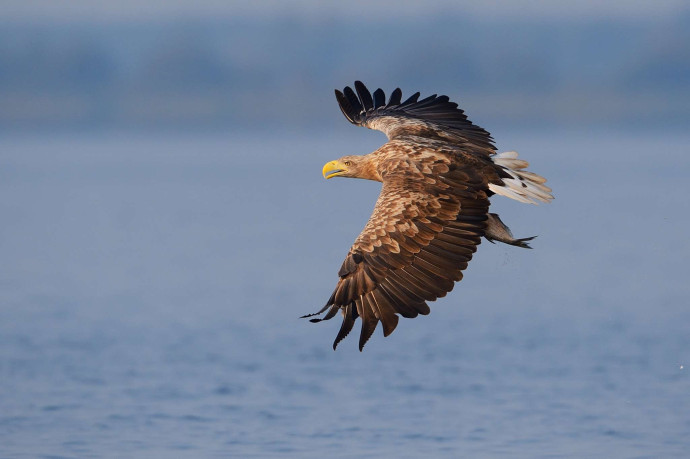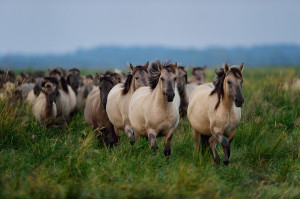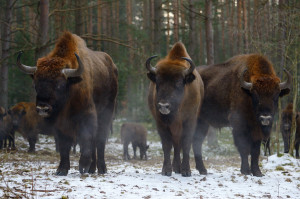The Oder Delta, straddling the border area of Poland and Germany on the Baltic Sea coast, has today officially become part of the Rewilding Europe initiative. After three years of intensive preparations with many different authorities and stakeholders, four organisations agreed to start working together to put the area on the European map as an inspiring example of rewilding, for the benefit of both people and nature. An event held today in Tanowo on the Polish side, with many local partners and stakeholders present, marked the start of this initiative.
The ‘Big Seven’ (Die Großen Sieben/Wielka siódemka) that will act as the most charismatic species in the area are white-tailed eagle, European beaver, European bison, elk, wolf, Atlantic sturgeon and grey seal – representing the great variety and connectivity in habitats that the Oder Delta already offers.

The Oder Delta, in total some 250 000 ha large, is a unique region with a rich mosaic of large, wild ecosystems on land, in the sea and in the freshwater systems. Through rewilding actions in the past, it is now one of the most exciting wild areas in north-central Europe, mainly managed by nature itself, where wildlife has begun to thrive in more natural densities. Not far from Berlin and close to Szczecin and resorts along the Baltic coast, this wild landscape can create new sources of income for the local people.
Naturally flowing rivers, heathlands, deltas, marshes, vast reed beds, alluvial and riparian forests, wild grasslands, bogs, coastal dunes, sand beaches and the open sea create the amazing diversity of the Oder Delta landscape located around the Szczecin lagoon. This creates suitable habitats and favourable living conditions for the ‘Big Seven’ and many more species.

Rewilding Europe, Stepnicka Organizacja Turystyczna (SOT), HOP Transnationales Netzwerk Odermündung e.V. and Deutsche Umwelthilfe (DUH) together with local and regional partners have recognized these positive developments and future opportunities. Therefore the organizations will work in cooperation with collaborating landowners and entrepreneurs to start pilot rewilding and enterprise initiatives benefiting both the local economy and nature. Different stakeholders such as local authorities, landowners, local inhabitants, tourism entrepreneurs and hunters are supporting the Oder Delta rewilding initiative. Landowners will be able to generate new ways of income and nature-based tourism enterprises can benefit from guests visiting the area to observe wildlife species and enjoy the wild nature.
Visitors from many other countries will be eager to see the iconic white-tailed eagle in the Oder Delta, having the highest breeding density in Europe. Nearly unknown fact is that there are around 160 European bison roaming freely not far from the Szczecin lagoon. Another special aspect is the possibility to observe that salmon, sea trout and sturgeon that return to their spawning grounds.

Rewilding and economic potential
– “Strategically located at one of the ecological crossroads in Europe, the Oder Delta holds an enormous natural capital. People realize and understand more and more that nature and wildlife are the region’s key resources, worth preserving. So, the diversity of species and the unique landscape provide a huge value that can be unlocked in support of the local economy, by developing and starting new economic models’’, says Ulrich Stöcker, head of Nature Conservation Department of Deutsche Umwelthilfe e.V. (DUH) and Team Leader for the German component of the Oder Delta rewilding area. ‘’Nature-based tourism can also create regional value for areas along the coast and in off-seasons like winter”.
– “With the Oder Delta as part of our initiative, we can show that also in northwest Europe there are opportunities for rewilding of large areas, with large cities and human concentrations at the doorstep”, says Frans Schepers, Managing Director of Rewilding Europe. ‘’The re-flooding of polders, restoration of marshlands, spontaneous comeback of species like elk and wolf and the transboundary cooperation that are all happening already, provide great momentum for this initiative’’.
An import pillar of the Oder Delta team’s work is to support local entrepreneurs in their efforts to connect their businesses with wildlife, wild nature and wilderness, ranging from guiding enterprises, wildlife watching hides, eco-lodges, local products, sustainable transport and environmental education.
“There is much potential that just needs to be exploited. During winter when the holiday beaches are abandoned, visitors can track wolves, watch small groups of elk feeding on willows in the snow-covered fields, and see white-tailed eagles that gather to hunt ducks around the still open water sections of the lagoon“, adds Iwona Krepic from Stepnicka Organizacja Turystyczna (SOT) and Team Leader for the Polish component of the Oder Delta rewilding area.
Rewilding history of Oder Delta region
The rewilding efforts will build on the experiences and achievements of different local organisations, NGOs, conservation authorities and governmental agencies that have in the past established the Wolinski National Park and reserves such as Olszanka, Czarnocin, Uroczysko Święta and Świdwie in Poland as well as the wilderness areas Ueckermünder Heide and Peenetal in Germany. For example, the restoration of the wetlands of the Peene River has brought back the full beauty of the landscape, already known as the “The Amazon of the North”. This restoration resulted in a major comeback and an increase in the population of wildlife species. The growth in populations of the white-tailed eagle, otter, beaver, salmon, sea trout and many other species was significant and can be now seen while exploring the region. As a result, Peene River has become a well-known nature-based tourism destination in Europe and is significantly contributing to the regional economy.
With Oder Delta as its eighth area, Rewilding Europe moves another step forward towards its target of developing 10 magnificent rewilding areas across Europe by 2022.
For more information about Oder Delta rewilding area see here. Follow our activities at Rewilding Oder Delta Facebook page.
